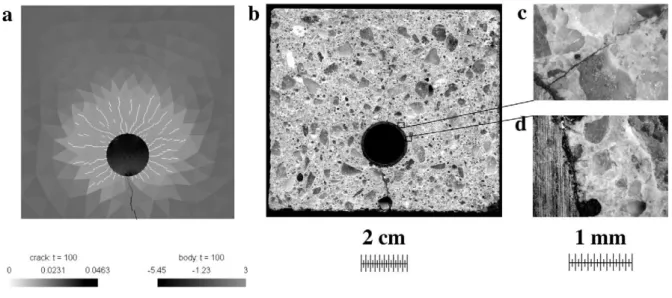ECCM 2010
IV European Conference on Computational Mechanics Palais des Congrès, Paris, France, May 16-21, 2010
Study of the size effect in a model to simulate concrete cracking due to
rebar corrosion and comparison to accelerated corrosion tests
B. Sanz1, J.P Planas1, J.M. Sancho2
1Dep. Ciencia de Materiales, E.T.S.I. Caminos, Universidad Politécnica de Madrid, Madrid, Spain, bsanz@mater.upm.es, jaime.planas@upm.es 2Dep. Estructuras de Edificación, E.T.S. Arquitectura, Universidad Politécnica de Madrid, Madrid, Spain, jose.sancho@upm.es
An immediate consequence of the corrosion of reinforcement in concrete structures consists in the generation of an oxide layer at the steel surface which, due to the greater specific volume of the oxide with respect to the steel, induces internal pressure on the surrounding concrete and thus cracks the concrete cover [1, 3]. Focussing on the prediction of the mechanical effects of the oxide expansion, a numerical model to simulate the effect of the oxide layer was programmed, assuming that the oxide layer expansion is given at a any specified time [5]. The basic ingredient of such a model is an interface element with zero initial thickness that incorporates both the expansive and mechanical behaviors of the oxide, which is characterized by its ability to debond, with nearly free sliding (very small shear stiffness) and nearly free separation in tension (strongly reduced normal tension stiffness). It was called expansive joint element and it has already been presented in previous conferences. Concrete cracking is simulated by finite elements with embedded adaptable cohesive cracks [4] that follow the basic cohesive crack model proposed by Hillerborg et al [2].
In this work, the expansive joint element has been improved by incorporating irreversible behavior and a thorough analysis is carried out to ascertain the (strongly) coupled effect of the size of the mesh, the time step, the numerical tolerance and the fracture properties of the concrete on the cracking pattern.
In parallel, accelerated corrosion tests have been carried out in order to verify the ability of the model to reproduce the oxide behaviour and the mechanical effects over the surrounding concrete. The crack patterns obtained in both cases are compared and discussed. The samples are concrete prisms with a steel tube inside simulating a rebar. The corrosion is simulated by the volumic expansion of the oxide. It is controlled by a single parameter, the corrosion depth, that is implicitly time-dependent. The influence of the element size is studied covering different ranges for the expansive joint element, the steel and the concrete. The cracking of the surrounding concrete is studied at different stages of the process for each case. In accelerated corrosion tests, constant current has been imposed in order to corrode the samples. The crack width at the concrete surface is recorded during the process and the crack pattern is studied after finishing the test. A special surface treatment is applied in order to improve the cracks detection. Finally, the results obtained from the simulations and from the tests are compared and the results are discussed.
Figure 1: (a) Crack pattern in numerical simulations using the expansion joint element. Crack width (mm) and maximum principal stress (MPa). (b) Crack pattern in accelerated corrosion tests. General view. A main crack is observed. (c) Detail of a secondary crack. (d) Detail of some radial micro-cracks.
root of one of the secondary cracks. However, when looking at the slice under the microscope, many micro-cracks around the bar are also seen, as shown in part (d), in accordance to the predictions of the simulations.
In the paper, the main aspects of the formulation of the element are reviewed and the effects of the numerical settings are analyzed in detail. The experimental procedure for accelerated corrosion tests is briefly described and some pictures of the experimental crack pattern after applying the surface treatment are shown. The results obtained from the simulations for different numerical settings are discussed and compared with the experimental results.
References
[1] Cover cracking as a function of bar corrosion: Part I - experimental test, C. Andrade, M.C. Alonso and F.J. Molina,Materials and Structures, Vol.26, 453–464, 1993.
[2] Analysis of crack formation and crack growth in concrete by means of fracture mechanics and fracture ele-ments, A. Hillerborg, M. Modéer and P.E. Petersson,Cement and Concrete Research, Vol.6, 773–782, 1976. [3] Cover cracking as a function of bar corrosion: Part II - numerical model, F.J. Molina, M.C. Alonso and C.
Andrade,Mater. Struct., Vol.26, 532–548, 1993.
[4] An embedded cohesive crack model for finite element analysis of concrete fracture, J.M. Sancho, J. Planas, D.A. Cendón, E. Reyes and J.C. Gálvez,Engineering Fracture Mechanics, Vol.74, 75–86, 2007.
STUDY OF THE SIZE EFFECT
IN A MODEL TO SIMULATE CONCRETE CRACKING
DUE TO REBAR CORROSION AND
COMPARISON TO ACCELERATED CORROSION TESTS
IV European Conference on Computational Mechanics
Paris, May 16th-21st, 2010
B. Sanz, J. Planas, J.M. Sancho
Dep. Ciencia de Materiales
SEDUREC
CONSOLIDER-INGENIO 2010
